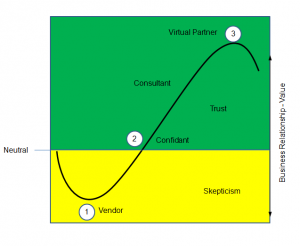As a services provider, earning the trust of our clients is paramount to our business success. Trust is something each of us must earn. I was taught in a customer development class that all business relationships follow a developmental S-curve (shown below). What if your company manufactures a product? Is the same relationship curve relevant? I propose that all businesses should desire to become a trusted partner of their consumer and that every relationship will follow this relationship curve provided that the business offering is relevant to the consumer.
When beginning a business relationship, all companies usually start at a neutral or slightly positive position. Both parties approach the relationship with a sense of apprehension. As relationships develop, both parties will experience some healthy skepticism. “Will the other party really do what they said?” At this point, there really isn’t much of a relationship. At this stage, the supplier is nothing more than a vendor (position 1). If supplier performance is so-so, the business relationship may end or at least stall at vendor position. If this happens, the supplier is highly vulnerable to the competition. After all, there is no real relationship. Furthermore, there is usually little tolerance for mistakes at this level of relationship. Even one slip, and the relationship is over.
parties approach the relationship with a sense of apprehension. As relationships develop, both parties will experience some healthy skepticism. “Will the other party really do what they said?” At this point, there really isn’t much of a relationship. At this stage, the supplier is nothing more than a vendor (position 1). If supplier performance is so-so, the business relationship may end or at least stall at vendor position. If this happens, the supplier is highly vulnerable to the competition. After all, there is no real relationship. Furthermore, there is usually little tolerance for mistakes at this level of relationship. Even one slip, and the relationship is over.
Through successful performance, most relationships will move above the neutral line to the position of confidant (position 2). When at this level of relationship, the confidant is no longer just another vendor. The client may begin to include the confidant in as a regular “bidder” for future work. In some cases, the client may include the confidant in their future planning sessions, particularly in the supplier’s area of expertise.
In the best cases, the confidant may receive upfront information of future work or needs. Although a confidant is still developing the relationship and earning trust, they will usually get a seat at the table with the other potential suppliers. With development of a trusting relationship and continued performance, businesses will move further up the curve to consultant.
A consultant will have even more influence with the client as a preferred supplier. When at this level of relationship, the consultant may be asked to assist in development of strategic planning. A consultant type relationship is developed through a significant investment in time and proven performance. This relationship is very strong and is based on mutual trust. Most likely, if the client requires anything that is within the consultant’s realm of expertise, the assignment is the consultant’s to lose.
Since the relationship is built on mutual trust, both parties are free to speak and share ideas freely with the intention of the betterment of all concerned. In this type of relationship, mistakes are tolerated and each party will work hard to resolve these issues to protect the relationship. As the relationship develops, the trust level increases and eventually the consultant will move to the pinnacle of the curve, the position of virtual partner.
A virtual partner has developed a strong mutual trust and respect with the client. Each party works hard to make sure the other is successful in every aspect of their business. This includes concern for areas outside of an individual’s or company’s expertise. The client will be willing to discuss and seek the virtual partner’s input on most major tactical and strategic decisions or company changes. The virtual partner will essentially be treated as an equal and an integral part of the team.
However, once reaching position 3, notice the curve doesn’t flatten out. In fact, it is possible to drop. The significance of this drop is dependent on the business relevance and relationships with individuals in each organization. People do business with people. A change in personnel or a major company shift can cause the curve to decline. Even when the relationship is strong, without business relevance the partner’s value can plummet. Take for example carbon paper sales (some of the people in my office had never heard of carbon paper).
Although in its day, carbon paper was invaluable to an office, today a carbon paper company would get little reception from anyone, regardless of the relationship level. This is when it’s appropriate to expand or change business offerings (begin climbing another S-curve). The key is to start developing the next S-curve at or before reaching position 3.
Who are your trusted partners? Whether you are the client or the supplier, traversing the relationship S-curve takes time. The best time to develop those relationships is before they are needed. In fact, I propose that you can’t have too many trusted partners.
 Paul V. Kumler, P.E. is president of KTM Solutions, an engineering company that services the aerospace and large scale manufacturing industries. In addition to aero structures engineering services, KTM Solutions designs and builds tooling supporting a broad clientele and various industries. The company is headquartered in Greer, South Carolina with remote offices in Charleston, South Carolina. Mr. Kumler serves in several volunteer roles including the SC Aerospace Advisory Board. Mr. Kumler, a professional engineer, is licensed in Louisiana, South Carolina, Texas and Washington. He is married to Ginger A. Kumler and has two grown children and two grand children.
Paul V. Kumler, P.E. is president of KTM Solutions, an engineering company that services the aerospace and large scale manufacturing industries. In addition to aero structures engineering services, KTM Solutions designs and builds tooling supporting a broad clientele and various industries. The company is headquartered in Greer, South Carolina with remote offices in Charleston, South Carolina. Mr. Kumler serves in several volunteer roles including the SC Aerospace Advisory Board. Mr. Kumler, a professional engineer, is licensed in Louisiana, South Carolina, Texas and Washington. He is married to Ginger A. Kumler and has two grown children and two grand children.


Be the first to comment on "Becoming a Trusted Partner"